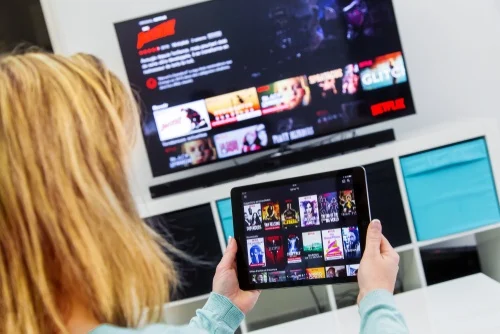Last week I was at MediaTech 360, TVBEurope’s dedicated event to all things MediaTech. The event aims to bring together industry players to discuss what the future holds for our industry.
While there was a ton of interesting discussion and concentration on the growth of OTT, the rise of the cloud, adtech, and immersive 360 video, conversation always reverted to, or focused on, two things: 1) how do we target the millennials? and 2) how do we choose a technology partner to help us during this period of change?
Over the top rises to the top
There were some interesting insights into the growth of OTT from David Sidebottom, Principal Analyst for Media and Entertainment at Futuresource Consulting. David started out by saying “five years ago, customer expectations were already ahead of what we could deliver”. Of course, the iPhone was the catalyst for change and triggered the TV everywhere movement, but while the device has been around for 10 years, it’s only in the last five that we have started to see the impact of this change on the MediaTech industry.
But there is another screen that has had a similar experience, where it has launched, and its impact only recognized recently—the smart TV. The launch of the smart TV five years ago was set to change how viewers engage with and consume content (helping boost the use of OTT services and on-demand content), but David said that really, it’s only in the last two to three years we’ve seen the impact of this device on the market—where sales have doubled to 22 million in three years.
But it’s not only devices that are driving a growth in OTT. It was David’s opening session on day 1 that kickstarted the conversations around millennials and how to engage with this audience. He revealed that when it comes to OTT, 69% of 16-25-year olds use Netflix (although 70% admitted they don’t pay for it), while 45% use Amazon Prime Video. Also, 31% do buy digital video—showing that this market is willing to pay for content. David also mentioned that 50% of this age group watch TV shows based on recommendations from their friends—making recommendations a big focus for OTT players.
Content is also increasingly crucial for the growth of OTT. According to Futuresource’s research, 51% of UK Netflix subscribers like or love Stranger Things (my love for Stranger Things means I am included in that 51%). Even more specifically, 2 out of 3 millennials like or love Stranger Things. Which strongly suggests that content, and the preferences of this age group, will be key driver for SVOD services.
And it seems that yet more change is on the horizon. Not only are we seeing diversification from players such as Amazon and Disney, but David thinks that voice will have a huge impact on search and discovery—with Amazon driving the sector. This is a huge change driver: Futuresource expects there to be 1 billion voice-enabled devices by 2021, adding significantly to content search and discovery capabilities. “Alexa, play ‘Game of Thrones, season 2, episode 4!”
How to see through the cloud
There is still a lot of discussion in the industry around the cloud, and the benefits of migrating to the cloud. But during the panel session at MediaTech 360, the discussion focused on the challenges of implementing the technology, as well as some interesting uses.
It was cited during the cloud panel that Sky used artificial intelligence technology during Harry and Meghan’s Royal Wedding to identify VIPs and celebrities arriving for the ceremony. This was made possible by combining services from multiple enabling vendors in Sky’s cloud environment.
But while the cloud allows new technologies to be used to launch new features and functions (especially for on-demand services), there are a lot of considerations. Although the cloud broadly promotes open standards (and thanks to this, a lot of the background work, such as procurement, servers, firewall rules etc. are usually in place), having the skills to navigate the cloud and build coherent cloud services for paying customers is key. These skills are especially important when broadcasters think about migrating to the cloud, away from traditional and legacy custom hardware infrastructure.
And this is where the panel said that vendors have a key role to play. While some skills will be needed internally, vendors can help fill the gap, providing much needed consultancy and bringing their skills to help broadcasters make the most of the cloud.
For example, while saving money is the biggest driver for the cloud, broadcasters need to understand how and when to use the cloud, as in some instances, using the cloud can actually increase costs, if a service requires a lot of bandwidth. It will be guidance and consultancy such as this, that will ensure that vendors are seen as a trusted partner.
Sport is child’s play
BBC Sport also took to the stage at MediaTech 360 to talk about it’s mission to redefine free-to-air sport for a digital age. And again, much of the focus was around how to engage with a younger audience, especially around big events such as the World Cup. And re-enforcing what Futuresource had said, the key to driving engagement with this group is through content.
BBC Sport is therefore focused on how it can deliver content to younger audiences in new ways. Typically, the BBC hasn’t had to worry about making its presence in the market known. But in an era of more content, more access to content, and a fight for eyeballs the BBC needs to up its game if it is to stay relevant in the new digital age. BBC’s key to this is construction and delivery of a seamless experience across its entire customer interface – TV, web, and social media. That takes a lot of organization, and a lot of enabling technology that is fully integrated.
What next?
It seems that during this period of change there are two opportunities. The first, is that broadcasters and content providers are looking to the millennials to drive growth. With a group that is happy to pay for content, and watching the majority of their content on demand, an opportunity exists here that should be maximized.
There is also an opportunity for vendors. In a period of change, broadcasters and content providers will be looking to technology partners to help guide them through this change. Media business consultant Christy King, who was the master of ceremonies for MediaTech 360, started off day 1 by saying that during this period of change, it’s harder than ever to find vendor partners.
Christy’s comments are something that have been voiced before, in our own research into the change brought by IP. In fact, more than half of broadcasters said it was harder to find the right partner. If vendors want to make the most of this opportunity, they need to show that they understand the market, understand the challenges broadcasters and content providers face, and can help them overcome this change.
So, while the kids are alright, if they don’t want to be left behind, vendors need to ensure they make themselves known.
















